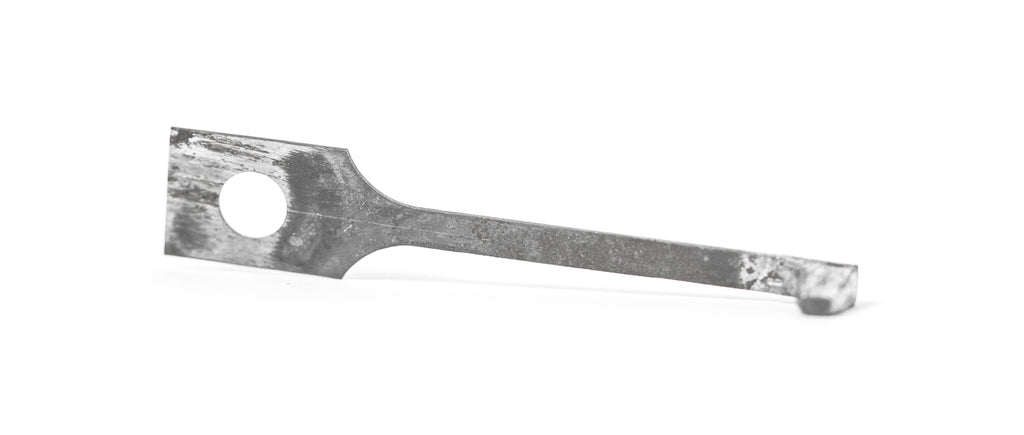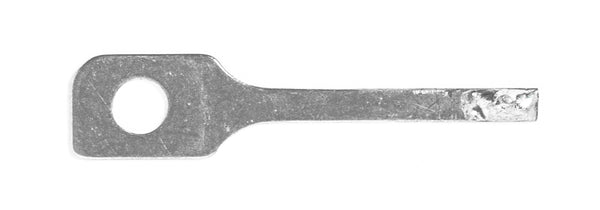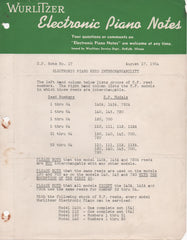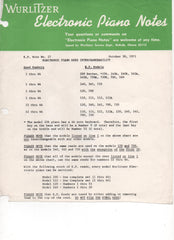In simplified terms, the Wurlitzer reed is a thin flat metal tone generator that when struck vibrates rapidly in an up and down motion or arc producing a tone. The length, width and thickness of a reed determine the character and pitch of the tone it produces (there are certain aspects of manufacturing I will omit that are not relevant to this discussion).
The tone is captured by a polarized pickup, sent to an internal amplifier where it is made much louder and ultimately played back through the speaker.
Models 110, 111, 112, 112A

The first era of reeds were produced from 1954 to 1957 with three different sized blanks, which varied from each other in length, width and thickness.
Size |
Reed Number |
Thickness |
Width |
Grinding* |
|
Lower |
1-20 |
.021” |
.135” |
No |
|
Middle |
21-50 |
.032” |
.110” |
Yes |
|
Treble |
51-64 |
.032” |
.097” |
Yes |
*A grinding process is utilized to shave off material from the thicker reed base with the mounting hole to the end of the tongue.
 112 reeds are thinner and narrower than later reeds. The corresponding slots in the reed bar pickup are also narrower and don’t effectively accept later era reeds. As a result, finding suitable replacements is very hard without modifying the pickup or reed. If you look closely most 112-era pianos have many improper reeds sprinkled throughout the reed bar affecting their sound.
112 reeds are thinner and narrower than later reeds. The corresponding slots in the reed bar pickup are also narrower and don’t effectively accept later era reeds. As a result, finding suitable replacements is very hard without modifying the pickup or reed. If you look closely most 112-era pianos have many improper reeds sprinkled throughout the reed bar affecting their sound.
112 Model Harp
It is now possible to easily install reeds into these pianos since Vintage Vibe has reproduced the proper 112 reeds. One trait of the 112 reeds is that there is no chamfer notched on the corner. The screws that secure the reed to the harp had a different thread than later Wurlitzer harps.
[[slideshow2]]Overall tone of the Wurlitzer 112 is greatly impacted by:
• The thinness of the lower reeds
• Close and tight reed to pickup spacing
•Tube pre amp and output amplification
• Alnico 6 x 9”speaker
• Solid wood case of the piano
All of these variables create a unique, earthy, warm and woody tone (almost reminiscent of early felt hammer Fender Rhodes pianos). When the amplifier gain is turned up, this piano can really growl like no other. This has everything to do with the thinness of the reeds, which allow the reeds to achieve greater flexibility of movement thus achieving a more dramatic arc inside a tight pickup enclosure. The more a reed swings or arc’s in front of the pickup the more harmonic distortion is achieved. This creates that growl or bark associated in the initial attack you hear upon a mid to hard blow. And the original alnico speaker breaks up very nicely adding to the odd harmonic tube compliment. Purchase Vintage Vibe 112 Reeds here
Models 120, 700
Like that of its predecessor, the 120’s reeds had no chamfer on the head. To reflect improvement Wurlitzer now added a fourth reed blank to the mix. These reeds were roughly produced from 1958 until around 1961.
Size |
Reed Number |
Thickness |
Width |
Grinding* |
|
Lower |
1-20 |
.020” |
.150” |
No |
|
Middle |
21-42 |
.020” |
.121” |
No |
|
Upper Middle |
43-50 |
.033” |
.111” |
Yes |
|
Treble |
51-64 |
.032 |
.098 |
Yes |
*A grinding process is utilized to shave off material from the thicker reed base with the mounting hole to the end of the tongue.

The harp was basically the same on the 120 as the 112 only minor changes to reflect pickup spacing. They did however add a more stable block of steel to the harp to make up for lost mass on the treble end. This was to ensure proper sustain or dwell. Unfortunately this improvement was one-step forward two steps back in regards to tuning and actual ease of repairing.
120 Model Harp
Interestingly, the reeds did not incorporate a grind until note 43 meaning they were flat stamped metal with appropriate lead applied to end. I have spoken with the original company that made the reeds for Wurlitzer and they told me about the stamping process and how hard it was to keep the dies sharp due to the hardened steel used on the reeds.
If you notice the middle section reeds on the 120 have gained .010 in width, thus making them unsuitable candidates for 112 substitutes. The lower reeds were also .015 larger in width making them unsuitable as well. For a 112-reed substitution the 120 reeds would either have to be filed down or, in the worst-case scenario, which should never be done, material removed from the reed bar. The only reason I even mention this as an option is because, much to my dismay, I have seen it done. Once a reed bar is filed you will never be able to use the proper reed in it again. This would be considered the ultimate hack job.
Overall tone of the Wurlitzer 120 is greatly impacted by: • The thinness of the Lower and Middle reeds
• Close and tight reed to pickup spacing
• Tube pre amp and output amplification
• Alnico 6 x 9”speaker
• Solid wood case with thin metal lid
All of these factors create tone unique to the 120. Similar to the 112, but instead of that exceptionally woody quality, the 120 has metallic overtones caused by the metal lid and its interaction with the internal speaker. Ray Charles made this piano and reed sound famous in his hit “ What I’d Say”
Models 140, 145, 720
For its next generation of electric pianos, Wurlitzer again produced the reeds from 4 different sized blanks, which varied in length, width and thickness.

Size |
Reed Number |
Thickness |
Width |
Grinding* |
|
Lower |
1-14 |
.020” |
.150” |
No |
|
Lower Middle |
15-20 |
.020" |
.125" |
No |
|
Middle |
21-42 |
.020” |
.120” |
No |
|
Upper Middle |
43-58 |
.031” |
.112” |
Yes |
|
Treble |
59-64 |
.031" |
.098" |
Yes |
*A grinding process is utilized to shave off material from the thicker reed
That being said, a bigger mechanical change was made that directly related to the reeds: the harp was split into independent upper and lower sections. This allowed the designers, with physics on their side, to fine-tune the mass in each section in order to produce the desired sustain, harmonics and dwell. This control was unavailable on prior single harps.

The design and modification of Wurlitzer harps is a mathematical nightmare for a layperson; it takes concrete understanding of physics, mass structure and acoustic vibrational design to do it correctly.
You may have found on occasion that no matter what you try, even after changing reeds and adjusting the strike line, you still can’t get a dull note to ring out. This comes down to the physics of the harp and it having not been tuned properly at the factory. You will notice that by applying counterweight to the harp, by adding a piece of metal or pressing hard against the harp with a screw driver, the note may change and start to dwell properly. It’s because you are changing the structure and mass of the harp. Often times by fixing one note you will inadvertently cause another to go bad. This is the physical nature of tuning the harp mass.
Even with the engineering improvements presented by Wurlitzer in this era they were just getting started with what was to come.
*Note that 140A, 145A, and 700A Wurlitzers Reeds use 200 style Reeds.
Models 106, 140B, 145B, 146, 200, 203, 206, 207, 214, 720B, 726B
 200 Series Reeds
200 Series Reeds
Wurlitzer was clearly on a design tear and as a result the number of reed blanks was increased from three to five and featured four different grind patterns.
[[slideshow1]]
Size |
Reed Number |
Thickness |
Width |
Grinding* |
|
Lower |
1-14 |
.020” |
.155” |
No |
|
Upper Lower |
15-20 |
.020” |
.129” |
No |
|
Middle |
21-42 |
.031” |
.120” |
Yes |
|
Upper Middle |
43-50 |
.031” |
.110” |
Yes |
|
Treble |
51-64 |
.031” |
.097” |
Yes |
*A grinding process is utilized to shave off material from the thicker reed
This is the classic era of Wurlitzer reeds. More reeds of this style were made than any other. The tone is characterized by long dwell and sharp attack.This style stayed around essentially from 1966 till 1975.
Purchase 200 series reeds today!
Models 200A, 200B and all 200A series pianos
For the last line of reeds, Wurlitzer continued with the 5 blanks established in the prior period, but changed its steel stock and increased the thicknesses of the Middle, Upper Middle and Upper blanks.
Size |
Reed Number |
Thickness |
Width |
Grinding* |
|
Lower |
1-14 |
.020” |
.155” |
No |
|
Upper Lower |
15-20 |
.020” |
.129” |
No |
|
Middle |
21-42 |
.032-.034” |
.120” |
Yes |
|
Upper Middle |
43-50 |
.032-.034” |
.110” |
Yes |
|
Treble |
51-64 |
.032-.034” |
.097” |
Yes |
*A grinding process is utilized to shave off material from the thicker reed base with the mounting hole to the end of the tongue.

Both the head and tongue of the reed were thicker which produced a smoother, rounder and mellower tone than 200 reeds. The thickness went from around .020” on the tongue of a 200 reed to .026” on the 200A, which is considerable but this difference is not easily discernible to the untrained ear, but when combined with the variation in amplifier design from the 200 to 200A, it becomes more audibly apparent. These reeds can easily be interchanged and blended with any of the reeds that came before in the 140B series as well as the 200 models.
I am including two original Wurlitzer tech memos stating interchangeability for reeds. I’ve tried to offer you some explanation as to the differences that aren’t provided therein. In short, dimensional changes to the reeds and harp pickup openings prevent some substitution of later for early reeds and in order to maintain tonal consistency across the keyboard substitution of early for later reeds is discouraged. In my research of available facts or proof I have come across certain discrepancies that have been omitted as to avoid confusion. I have been servicing Wurlitzer electric pianos for 20 years and this information comes from my personal stock of reeds and harps and knowledge.
written by Chris Carroll
1964 |
1971 |
 |
 |
 Our piano website
Our piano website














